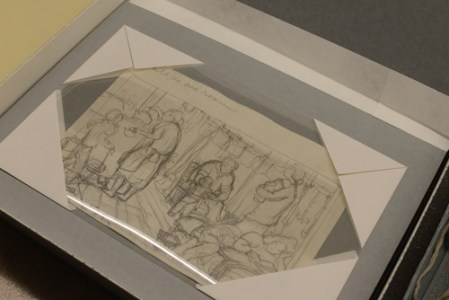Now through December 31, 2018, the Heart Mountain Interpretive Center in Wyoming is staging the first significant showing of Estelle Peck Ishigo’s work in nearly 50 years. The Mountain Was Our Secret: Works by Estelle Ishigo includes ten watercolors by the artist on loan from JANM’s Allen Hendershott Eaton Collection and several of the artist’s pencil sketches, courtesy of the Bacon Sakatani collection.
Born in Oakland, California, in 1899, Estelle Peck was raised by a series of relatives in Southern California. In her twenties, Peck attended Otis Art Institute where she met and fell in love with aspiring Nisei actor Shigeharu Arthur Ishigo. Due to anti-miscegenation laws at the time, the pair were unable to marry in the United States, so they wed in Mexico in 1929.
When Japan bombed Pearl Harbor on December 7, 1941, many businesses fired employees of Japanese descent. Estelle, because of her marriage, lost her position as an art teacher. When her husband was forcibly removed and incarcerated at Pomona, and later Heart Mountain, Estelle opted to go with him.
Because of her background as an art teacher, Estelle was recruited as a documentary reporter for the US War Relocation Authority. With this job, it was her responsibility to record the Heart Mountain experience in illustrations, line drawings, and watercolors. As evidenced in her art and writing, Estelle took her official work as a documentarian for the WRA seriously, making sure to accurately document the miserable conditions at the camp. Many of her pieces illustrated the lack of privacy and comfort in living quarters and latrines. Like many Heart Mountain artists, Estelle’s work often depicted the mountain itself, an imposing figure in a desolate landscape.

Estelle first began documenting conditions in the camp by using watercolors. However, she admitted to being frustrated by watercolor’s inability to fully capture the conditions in which Japanese Americans were forced to live, calling the medium too “clean and untroubled.” To remedy this shortcoming, Estelle created more charcoal and pencil drawings, many of which are in JANM’s online collection.
When she was released from Heart Mountain in 1945, all the art that she had created was considered the property of the government and seized. She managed, however, to smuggle out many pieces by hiding them between her and Arthur’s clothing. After the war, the Ishigos returned to Southern California and lived in a trailer park. They struggled to find steady employment. Arthur died in 1957, and Estelle lived hermetically until 1972 when her artwork was rediscovered and included in a California Historical Society exhibition. That same year, she worked with the Hollywood Chapter of the Japanese American Citizens League to publish a book, Lone Heart Mountain, which recounts individual stories as well as shared realities of persons of Japanese descent before, during, and after incarceration.
In 1983, filmmaker Steven Okazaki heard of her story and sought to make a documentary about Estelle. While doing research for his film, Okazaki discovered Estelle was living in poverty and residing in a Los Angeles basement apartment. When he told her about his project, Estelle said, “I’ve been waiting for someone to tell my story. Now I can die.” She passed away in 1990, just before the release of the film, Days of Waiting, which went on to win a Peabody Award and an Academy Award for Best Documentary (Short Subject).

Through her work, Estelle showed the duality of the American concentration camp experience. She had the unique ability to capture both the quotidian, tedious activities required for daily survival as well as scenes of respite, brief moments of joy amidst trauma. An excerpt from her book, Lone Heart Mountain, notes this binary experience: “Gathered close into ourselves and imprisoned at the foot of the mountains as it towered in silence over the barren waste, we searched its gaunt face for the mysteries of our destiny: and some spoke its name with the same ancient reverence, felt for their own mountains in Japan.”
The Mountain Was Our Secret is included with admission at the Heart Mountain Interpretive Center, which is $9 for adults and $7 for students and seniors. Children under 12 and members of the Heart Mountain Wyoming Foundation are free. More information is available on their website.






















![Estelle Ishigo (Gift of Mary Ruth Blackburn, Japanese American National Museum [2000.103.12])](https://i0.wp.com/media.discovernikkei.org/articles/4279/ishigo2.jpg?resize=269%2C215)

